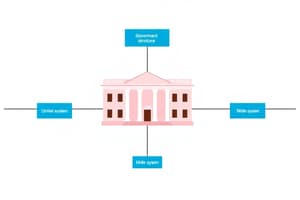Podcast
Questions and Answers
Which statement about federal and unitary systems is most accurate?
Which statement about federal and unitary systems is most accurate?
- In a federal system, the constitution allocates powers between states and federal government. (correct)
- In a federal system, powers are lodged in the national government.
- Unitary systems are more democratic than federal systems.
- Both systems create equal levels of autonomy for state governments.
Which statement is most accurate about the sources of revenue for local and state governments?
Which statement is most accurate about the sources of revenue for local and state governments?
- All revenue comes from sales taxes.
- Local governments do not receive any state funding.
- Local and state governments rely solely on taxes for revenue.
- Between 30 and 40 percent of their revenue comes from grant money. (correct)
What key constitutional provisions define the scope of authority of the federal and state governments?
What key constitutional provisions define the scope of authority of the federal and state governments?
Article I, Section 8; supremacy clause of Article VI; Tenth Amendment; Article I, Sections 9 and 10; Bill of Rights; Fourteenth Amendment; civil rights amendments.
What are concurrent powers?
What are concurrent powers?
What is an ex post facto law?
What is an ex post facto law?
What is federalism?
What is federalism?
What is a unitary system?
What is a unitary system?
What were the implications of McCulloch v. Maryland for federalism?
What were the implications of McCulloch v. Maryland for federalism?
What is cooperative federalism?
What is cooperative federalism?
What is dual federalism?
What is dual federalism?
What is new federalism?
What is new federalism?
Which statement about federal grants in recent decades is most accurate?
Which statement about federal grants in recent decades is most accurate?
Which statement about unfunded mandates is false?
Which statement about unfunded mandates is false?
What is a block grant?
What is a block grant?
What is a categorical grant?
What is a categorical grant?
What is creeping categorization?
What is creeping categorization?
What are unfunded mandates?
What are unfunded mandates?
Which statement about federal and unitary systems is the most accurate?
Which statement about federal and unitary systems is the most accurate?
In McCulloch v. Maryland, the Supreme Court invoked which provisions of the constitution?
In McCulloch v. Maryland, the Supreme Court invoked which provisions of the constitution?
Which statement about new federalism is not true?
Which statement about new federalism is not true?
Which is not a merit of cooperative federalism?
Which is not a merit of cooperative federalism?
Which of the following is not a benefit of federalism?
Which of the following is not a benefit of federalism?
All of the following are concurrent powers of the federal government and state government except _____
All of the following are concurrent powers of the federal government and state government except _____
What clause in the Constitution makes an adoption certificate valid in any state?
What clause in the Constitution makes an adoption certificate valid in any state?
A federal structure of government aims to balance the power between the national and state governments. The United States perfectly demonstrates this principle as there has been a clear balance of power between the federal government and the state governments since the founding of our nation.
A federal structure of government aims to balance the power between the national and state governments. The United States perfectly demonstrates this principle as there has been a clear balance of power between the federal government and the state governments since the founding of our nation.
_____ are federal laws and regulations that impose obligations on state and local governments without fully compensating them for the administrative costs they incur.
_____ are federal laws and regulations that impose obligations on state and local governments without fully compensating them for the administrative costs they incur.
Study Notes
Federal and Unitary Systems
- Federal systems allocate powers constitutionally between states and the federal government.
- In unitary systems, power is centralized in the national government.
Revenue Sources for Local and State Governments
- 30 to 40 percent of revenue for local and state governments derives from grant money.
Authority of Federal and State Governments
- Federal and state powers outlined in:
- Article I, Section 8 (federal powers)
- Supremacy Clause (Article VI)
- Tenth Amendment (state powers)
- Limitations on authority specified in:
- Article I, Sections 9 and 10
- Bill of Rights
- Fourteenth Amendment
- Civil Rights Amendments
Concurrent Powers
- Shared powers include taxing, borrowing, law-making, and establishing court systems.
Ex Post Facto Law
- Refers to laws that criminalize actions retroactively, which are prohibited by the Constitution.
Federalism
- An arrangement creating two autonomous levels of government, both with direct authority over people.
Unitary System
- A centralized government structure where lower levels depend on the central authority, emphasizing concentration of power.
Implications of McCulloch v. Maryland
- Established doctrine of implied powers for the federal government to create necessary policies.
- Affirmed national supremacy, reinforcing federal law over state law.
Cooperative Federalism
- Characterized by coordination between state and federal governments to address national issues, resembling a marble cake structure.
Dual Federalism
- Defined by distinct spheres of authority where states and national government operate independently, compared to a layer-cake model.
New Federalism
- Advocates for decentralization to enhance efficiency, cut public spending, and improve outcomes.
Federal Grants Trends
- Federal grant funding to states has increased steadily since the 1960s.
Unfunded Mandates
- Imposed federal obligations on state/local governments without complete financial reimbursement for implementation costs.
Block Grant
- A form of funding with fewer federal restrictions that allow more flexibility in spending allocation.
Categorical Grant
- Targeted federal funds with strict rules on usage and detailed administrative control.
Creeping Categorization
- Process where the national government adds new conditions to block grants or replaces them with categorical grants.
Full Faith and Credit Clause
- Ensures that legal documents, like adoption certificates or driver’s licenses, issued in one state are recognized in other states.
Federal Structure Misconception
- The claim that there has been a perfect balance of power between federal and state governments since the nation's founding is false.
Economic Equality and Federalism
- Federalism does not inherently promote economic equality across the country.
Studying That Suits You
Use AI to generate personalized quizzes and flashcards to suit your learning preferences.
Description
Test your knowledge of federal and unitary systems and the sources of revenue for local and state governments with these flashcards. This quiz covers key concepts from Chapter 3 of PSCI 180: American Government, providing an engaging way to reinforce your understanding of important governmental structures.




